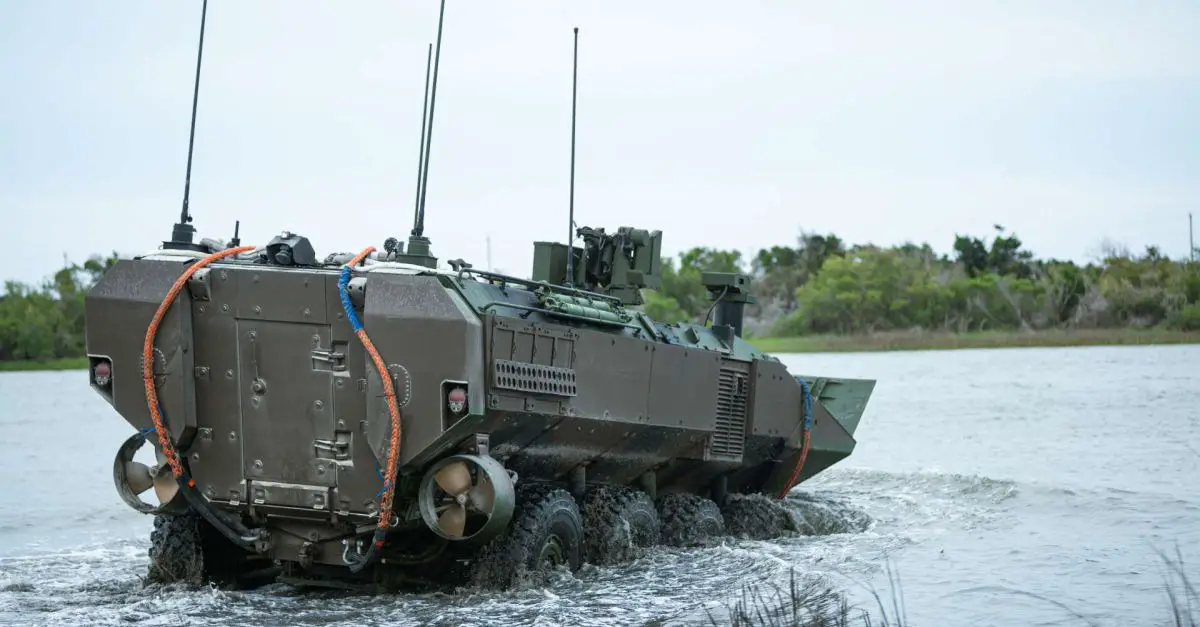Breaking news
US Marine Corps Successfully Tests New ACV Amphibious Combat Vehicle at Camp Lejeune.
The U.S. Marine Corps recently conducted a crucial test of their latest Amphibious Combat Vehicle (ACV) during a simulated retrieval exercise at Courthouse Bay, located within Marine Corps Base (MCB) Camp Lejeune. This exercise marked a significant step in evaluating the functionality and effectiveness of the ACV, which is set to replace the aging assault amphibious vehicle.
Follow Army Recognition on Google News at this link

U.S. Marines with Marine Corps Systems Command (MARCORSYSCOM) and 2nd Amphibious Assault Battalion, 2nd Marine Division, drive an Amphibious Combat Vehicle (ACV) into a body of water during an amphibious operations exercise in Hubert, North Carolina. (Picture source U.S. DoD)
The ACV is the Marine Corps’ latest advancement in amphibious operations. It is designed to enhance Marines' capabilities and survivability in diverse and challenging environments. The test at Camp Lejeune aimed to assess the vehicle's performance in real-combat conditions, ensuring it meets the rigorous demands of modern amphibious warfare.
During the exercise, the ACV demonstrated its ability to maneuver through water and onto land, showcasing its versatility and robust engineering. The Marine Corps is focused on ensuring that the ACV can seamlessly transition between maritime and terrestrial operations, providing a critical asset for future missions.
Officials at Camp Lejeune emphasized the importance of such tests in validating the ACV's design and operational readiness. "This exercise is pivotal in our efforts to equip our Marines with the most advanced and reliable vehicles," said a Marine Corps spokesperson. "The ACV's performance today is a testament to our development teams' hard work and dedication."
The successful testing of the ACV marks a promising step forward in the Marine Corps ongoing efforts to modernize its fleet and maintain a state of readiness for amphibious operations worldwide. As the Marine Corps continues to evaluate and refine the ACV, the focus remains on ensuring that the vehicle meets the highest standards of performance and reliability and is ready to support the needs of the Marines in any theater of operation.
The U.S. Marine Corps' latest Amphibious Combat Vehicle (ACV) represents a significant upgrade from the older assault amphibious vehicle, incorporating advanced technologies and design improvements to enhance amphibious operations. The ACV is manufactured by BAE Systems in collaboration with Iveco Defence Vehicles. This partnership leverages BAE Systems' extensive military vehicle production experience and Iveco’s high-performance automotive engineering expertise.
The contract for the ACV program was awarded to BAE Systems in June 2018, following a competitive selection process. The initial contract covered the production of 30 vehicles, with options for additional vehicles in subsequent phases. As of 2024, the Marine Corps has placed orders for several hundred ACVs, with a total planned procurement of up to 700 vehicles over the next decade, valued at approximately $1.2 billion.
The ACV is equipped with an advanced suspension system and robust powertrain, providing superior off-road mobility and agility in various terrains. It can run at a speed of up to 105 km (65 miles) per hour on land and 11 km/h (6 knots) in water, ensuring rapid deployment and versatility in diverse operational environments. The vehicle features enhanced armor and a V-shaped hull designed to provide improved protection against improvised explosive devices (IEDs), mines, and ballistic threats. Integrated blast protection and energy-absorbing seats further safeguard crew members and passengers.
The ACV is armed with a remote weapon station that can be equipped with a 30mm cannon, machine guns, and missile systems, providing significant firepower. State-of-the-art command and control systems, including advanced communication and navigation technologies, enable seamless coordination with other military units and assets. Designed for seamless transition between land and water operations, the ACV features waterjet propulsion for enhanced maneuverability in aquatic environments. It can be deployed from Navy ships and operating in open water, making it ideal for amphibious assault missions.
The ACV can carry up to 13 Marines plus a crew of three, providing ample space for personnel and equipment. Improved ergonomic design and climate control systems ensure greater comfort and endurance for occupants during extended missions. The new ACV embodies the U.S. Marine Corps’ commitment to maintaining technological superiority and operational readiness in amphibious warfare, ensuring that Marines are equipped with the best possible tools to accomplish their missions.


























